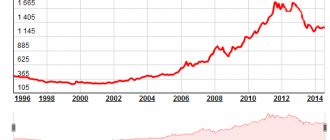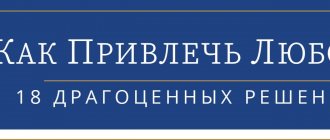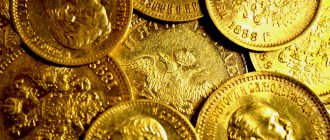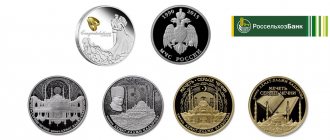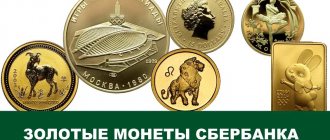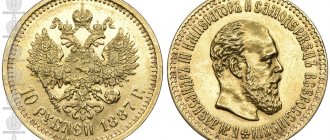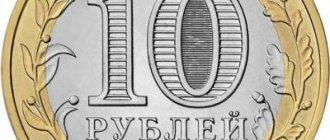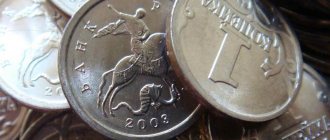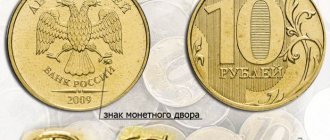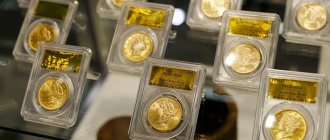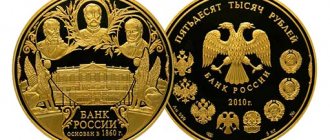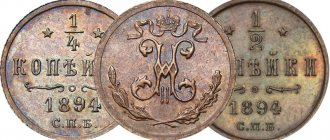In domestic numismatics, the borderline is the year 1700, when the monetary reform of Peter the Great transformed the appearance of circulating coins, setting them initial standards, which were improved under subsequent rulers. The transformations also affected the minting of gold coins. In the pre-Petrine era, of course, gold coins were issued, but they could hardly be called a full-fledged circulating medium. They were often given as a reward, so they served not only the function of a coin, but also a medal (this is evidenced by the holes on the coin where a cord was threaded to wear the coin around the neck). Few such specimens have survived, which is why experts agree that gold coins of those times were initially rare. Let's see what gold coins were issued in Russia before 1700.
Zlatniki of Prince Vladimir
The end of the tenth century - this is where the starting point of the production of Russian gold coins is hidden. This is the period of the princely power of Vladimir the Holy, Svyatopolk the First and Yaroslav the First Vladimirovich. The design of the coins borrows from Byzantine art. The obverse side of the coin was decorated with a portrait of the Grand Duke, who always held a trident (for Kievan Rus it represented a symbol of supreme power). On the other side was the face of Jesus Christ. In the hand of the Son of God was the Gospel. This side marks that the Russian lands accepted Baptism.
Above we present a gold medal from the 10th-11th centuries of Prince Vladimir from the Hermitage collection. Zlatnik is considered the first Russian coin. So far, only eleven similar coins have been found. It was also called “zolotnik”. This is where the roots of the unit of measurement of mass of the Russian system of measures grow, as well as the famous folk proverb “Small is the spool, but dear.”
Byzantine ancient coins
Metal money of Byzantium appeared already in our era at the turn of the 4th-5th centuries. during the reign of Anastasia. Previously, the state's monetary policy was based on the Roman one, completely imitating its system. Money was minted from gold from silver (solidus and miliarisium, respectively), and copper follis were also in circulation. The design of ancient Byzantine coins most often contained portraits of saints or emperors. Until the 7th century, all inscriptions on them were made in Latin, in a later period - in Greek.
Ugric gold and shipmen
For a long time, while the Russian lands were under the rule of the Golden Horde, gold coins were not issued. Samples for the reincarnation of gold came from the west, when merchants began to bring Hungarian ducats. They were adapted for recoining into Russian money. Hence their name “Ugric” or “Ugrians” (remember the German name for Hungary - Ungarn). The brought coins served as the standard: weight - 3.47 grams, fineness of the precious metal - 986. Under Ivan the Third, St. Vladislav was depicted on the coins. Vasily the Third Ivanovich minted money from gold, where on one side there was a rider on a horse, and on the other, a double-headed eagle. Ivan the Fourth (the Terrible) placed a double-headed eagle on both the obverse and the reverse.
One of the rarest coins of that era is the Shipman presented above. It is known in one copy (kept in the Hermitage collection). This is both a coin and a medal. Since the names of Ivan III Vasilyevich and his son Ivan Ivanovich are on the coin, experts believe that we are talking about the period of their joint reign. Therefore, the coinage was minted between 1471 and 1490. The model for the coin was the English Nobel.
Ancient Roman coins
On the territory of Ancient Rome, metal money appeared even later, closer to the 4th century BC. The very first samples were made of copper and bronze. These were different denominations and their smaller derivatives. As expected, images of Roman gods were used as a drawing. After 2 centuries, silver and, less often and irregularly, gold began to be used for minting means of payment; bronze coins also remained in use. These were denarii and victoriat. The obverse of all means of payment continued to bear images of deities, and then emperors.
Chervonets of Boris Godunov
Let us separately consider the Ugric chervonets of Boris Godunov. It is also a reward coin. The king awarded such coins for faithful service. The ruler's title was so long that it was placed on both sides of the coin. On one of them the beginning “By the grace of God, great sovereign, tsar” was stamped, and the ending “Boris Fedorovich, autocrat of all Rus'” had to be found on the back.
False Demetrius also left his mark on history with gold coins. It should be noted that the Hungarian ducat remained the model for them. Above you can see a very interesting copy of the “Wedding” gold coin worth 10 Ugric ducats (otherwise this coin is called “Portuguese”), minted during the reign of False Dmitry I. It is also kept in the Hermitage.
The last of the Rurikovichs on the Russian throne, Vasily Shuisky is considered one of the first reformers of the monetary sphere in Russia. Severe necessity forced him to smelt coins from gold. All silver suitable for minting was given as payment for services to military mercenaries - the Swedes. Even “Novgorodki” (kopecks) and “Moskovki” (dengi) had to be made in gold. The coins minted in his era are called “golden scales.”
Ancient Greek coins
The concept of ancient Greek coins includes not only metal banknotes of Ancient Greece itself, but also of a number of colonies. Following Lydia and Ionia, they began to produce their own Athenian tetradrachms, which became very popular. Then staters from Rhodes and Cyzicus, cast in gold, are put into circulation. Copies were made of the most significant and popular coins, which spread throughout the territory of Ancient Greece. As for the images, they were very diverse from animals, gods and sea monsters to emperors, heroes, weapons and all kinds of sacred and everyday objects. Many drawings were dedicated to major historical events.
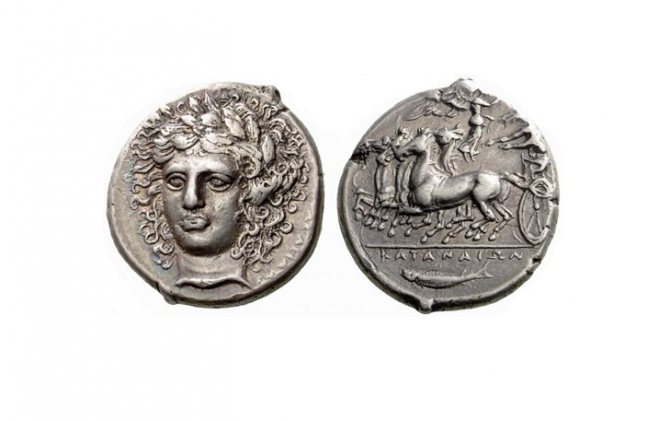
Gold of the Romanovs
Under the Romanovs, gold money and kopecks remained, but, as in the old days, they served as rewards. During the reign of Mikhail Fedorovich. The weight of a gold premium penny was 0.65 grams, and the gold premium money was 0.32 grams. But chervonets, half-chervonets and quarter-chervonetsy took their place in the row of gold coins. A double chervonets with a half-length depiction of Alexei Mikhailovich is known. The norm of gold coins was calculated, as before, from the ducat. Therefore, coins were obtained in three-quarters or a quarter of the Ugric.
A special throne with two seats, currently kept in the Armory Chamber, serves as the best symbol of the dual reign of Ivan the Fifth and Peter the Great. True, history experts will immediately remind you that Sophia really ruled for them. This interesting distribution of power was also reflected in the gold coins distributed as rewards for the Crimean campaigns. Sometimes, instead of portraits, a double-headed eagle could be seen on a coin, on both sides.
But the year 1700 was approaching, when Peter the Great received real power over the Russian Empire. The Rubicon was crossed, and after the monetary reforms carried out, domestic numismatics opened up completely new pages.
Svyatopolk the Accursed (1015-1016,1018-1019)
Silver coin of Svyatopolk (prince on the throne, trident with a large cross) No. 1
Silver of Svyatopolk (prince on the throne, trident with a large cross)
Date of issue: 1016-1018 Mint: Kyiv or Chernigov Metal: Silver Standard weight: ~3 g Standard diameter: ~26 mm Varieties: 3
Silver coin of Svyatopolk (Apostle Peter with an inclined cross, trident with a large cross) No. 2
Silver coin of Svyatopolk (Apostle Peter with an inclined cross, trident with a large cross)
Date of issue: 1015-1018 Mint: Kyiv or Chernigov Metal: Silver Standard weight: ~3 g Standard diameter: ~25 mm
Silver coin of Svyatopolk (Apostle Peter with a straight cross, trident with a small cross) No. 3
Silver coin of Svyatopolk (Apostle Peter with a straight cross, trident with a small cross)
Date of issue: 1015-1018 Mint: Kyiv or Chernigov Metal: Silver Standard weight: ~3 g Standard diameter: ~25 mm
Spread of coin production
Almost simultaneously with Moscow, coinage appeared in Nizhny Novgorod, the capital of the Suzdal-Nizhny Novgorod principality. At the beginning of the 15th century, money began to be minted in Tver, and then Novgorod and Pskov. In the second half of the 15th century, appanage principalities (usually in the vicinity of Moscow) also had their own coins. For a long time, coinage was carried out by moneymakers (“silversmiths”) - artisans who made stamps and minted coins at the prince’s order. Each coiner put his own mark on the coin, this now allows numismatists to catalog individual coins. With the development of coin circulation, moneymen began to hire minters. The first real mints (money) appeared only after the unification of Rus'.
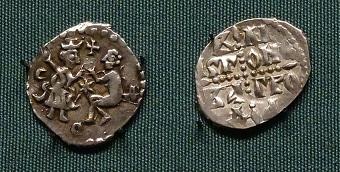
Coins of Novgorod (from the Hermitage exhibition)
Moneymen were hired by princes from among merchants who had a lot of silver. The moneyman who received the right to mint could distribute his coins through trade, thereby developing the influence of the prince. One and the same moneymaker could simultaneously work on the coins of different princes, or move from one to another. In the 15th century, the Golden Horde yoke greatly weakened; many princes became so powerful that they refused to pay tribute. The Battle of the Ugra in 1480 put an end to Tatar-Mongol influence. Foreign coins almost disappeared from circulation, and trade flourished. Russian coins now formed the basis of monetary circulation not only in Rus', but also in the former territories of the Golden Horde. At this time, additional “change” coins appear - half denga and quarter. In Tver and Novgorod, copper pools were widespread, comparable in shape and size to money, but they were valued many times lower. It is assumed that the pool could be equal to 1/60 denga, but this is a conditional ratio that could change several times.
Copper pool of Novgorod
At first, Novgorod and Pskov money were also minted from hryvnia ingots, but from one ingot they were made into 216, and not 200, as in Moscow. Gradually, the weight of money decreased, representing a kind of “inflation” of the Middle Ages. During the time of Ivan III, the average weight of Moscow denga decreased from 0.8 g to 0.4 g. To distinguish lightweight Moscow coins from Novgorod coins, they were given names - “Moskovka” and “Novgorodka”. The images on the coins were different. In Moscow, the image of a horseman with a saber (probably the prince, or St. George the Victorious) was gradually established on the reverse side of the inscription. On early coins you can see a horseman with a spear, or a bird, which, starting with Ivan the Terrible, began to be depicted on kopecks and half coins. On the money of Novgorod, Pskov and Tver, as well as partly on the coins of Vasily the Dark, the scope for creativity is simply enormous: here you can see animals, birds, trade scenes, horsemen, mythical creatures, ornaments, devils and even a double-headed eagle. There are many coins with double-sided designs, in which case the inscription is made around the circumference. Due to the limited size and uneven shape of the circle, images and inscriptions did not always fit on the coin.
Coins of the Grand Duchy of Tver (from the Hermitage exhibition)
Even with a clearly legible inscription, it is difficult to draw a conclusion about the place of minting. The full name of the prince was not always indicated; abbreviations were often made, or the inscription was generally placed: “Grand Duke”, “seal of the prince”, etc. In many cases, only the first name is provided. Given the number of appanage and grand dukes, it is sometimes possible to draw a conclusion about the place of coinage only with the help of similar types of images, or identical money signs. For example, if a sign is present on a coin of Vasily the Dark and on an unreadable one, then most likely these are coins of the same period. It was not customary at that time to indicate exact dates. An interesting example of the flourishing of an individual city solely due to trade can be observed by examining the coins of Torzhok. This city, as mentioned above, was located at the junction of the Tver and Novgorod principalities, where active trading activities were carried out. These coins are very rare, the weight is within 0.36 g, a bird is depicted on the front side, and the inscription “Novotor” (“Novy Torg” was the name of the city in those days) on the back side. On the territory of the former Ryazan principality, treasures with very unusual coins are found. All of them are quite heavy (0.9-1 g) and have a large diameter. The earliest examples are Tatar coins with a tamga stamped on top of them - a special sign of the Ryazan princes, reminiscent of a ram's head. Ryazan was very closely connected with the Golden Horde, and in many ways it was even closer to it than to Rus'. To maintain friendly ties with its powerful neighbor, it more than once united against Rus'.
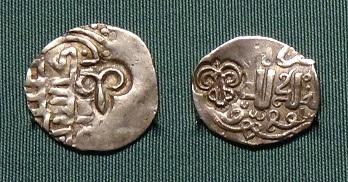
Coins of the Grand Duchy of Ryazan (from the Hermitage exhibition)
With the weakening of the Tatar influence, the Golden Horde coins began to be completely re-minted and, in addition to the tamga, the title of the Grand Duke was added. Under Ivan Fedorovich (1427-1456), traces of recoining are no longer observed. And later, until the beginning of the 16th century, lightweight coins without tamga, similar to Moscow ones, but with images of animals, began to be made in Ryazan. This indicates close ties with Moscow. There were even copper pools, like those in Novgorod and Tver.
Tver pools (from the Hermitage exhibition)
In Novgorod and Pskov, it was customary to indicate the place of minting in the form of letters, or in plain text. On the money of Pskov these are the letters “PS”, and those of Novgorod are “N” or “denga Novgorodskaya”.
Coins of the appanage principality of Galich (from the Hermitage exhibition)
Under Vasily the Dark, there was a struggle with the Galician appanage princes, who, by the way, also minted their own coins. To establish central power, the inscription “all Russian lands” was sometimes placed on coins of this period. Then the inscription “Ospodar of all Rus'” (that is, sovereign of all Rus') appeared on absolutely all Moscow coins, which existed until the reform of 1534-1547.
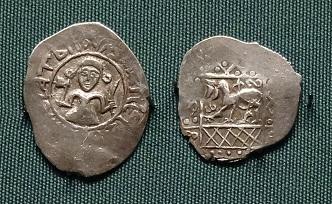
Coins of the appanage principality of Dmitrovsky (from the Hermitage exhibition)
Let's imagine a Novgorod market in the 15th century. A cobblestone-paved area with countless counters where you could find almost everything: from bread and kvass to overseas curiosities (porcelain, tea). Merchants in expensive attire mingled with peasants in bast shoes and traditional Russian shirts. The smell of locally caught fish and mead, which was brewed there, could be heard everywhere. The sellers shouted over each other, praising their goods. The poorer strata of society, as a rule, lived off their own households, but they still had to go to the market to buy winter clothing and tools. There they exchanged bags of grain directly or for coins. There were no pockets on clothes, bags of coins were simply tied to the belt, and sometimes money was even hidden in the mouth from the ubiquitous thieves. Counting tiny coins of different weights and sizes caused considerable difficulties, so merchants had to be generalists. Using simple devices, they determined the standard of silver and knew the places where coins were minted. Seeing a small coin with a bird, the merchant understood: “this is a Moscow coin,” and the larger one with the image of a crowned head was immediately associated with Pskov - this is the mythological Prince Dovmont, the patron of the city. An experienced eye immediately recognized their Novgorod coins: two quite distinct figures symbolizing the worship of Hagia Sophia, although there were other images.
Coins of the appanage principality of Mozhaisk (from the Hermitage exhibition)
There are practically no facts of coin counterfeiting, or they are simply difficult to recognize from the entire variety of money supply. Counterfeiters at that time usually used one method called "haircutting." Because the coins were irregularly shaped and varied in size, few would notice the cut edge except perhaps experienced merchants or when weighing a batch of coins. Having collected a large number of scraps, it was possible to smelt a piece of silver, or to imitate a coin in circulation. At that time, counterfeiters were called “crazy people”; on some Tver and Moscow coins there are even threatening inscriptions addressed to these “crazy people”. Top
The emergence of the ruble
From the 12th century, “chopped” money began to appear in the circulation of Kievan Rus, which was made from silver hryvnia. It was a silver rod, which included 4 “chopped” parts. Each such piece had notches indicating its weight and, accordingly, cost.
Each ruble could be divided into 2 halves, then they were called “half”. Since the 13th century, all hryvnias gradually acquired the name “ruble”, and from the 14th century they began to bear the marks of masters, the names of princes and various symbols.
Coins of Ancient Rus' were used not only to pay for goods, but also to pay fines to the prince’s treasury. Thus, for the murder of a free citizen, the punishment was the highest measure - “vira”, which could cost from 5 hryvnia for a smerd and up to 80 hryvnia for a noble person. For injury caused, the court imposed punishment of half-virye. “Slander” – the fine for slander – was 12 hryvnia.
Payment of taxes to the princely treasury was called a “bow,” and the law itself, issued by Yaroslav the Wise, was called a “bow to the faithful,” indicating the amount of tribute levied from each community.
The beginning of coinage in Moscow
In the second half of the 14th century, Dmitry Donskoy, the grandson of the first Moscow prince, Ivan Kalita, ascended the throne in Moscow. He became the first who was able to give a decisive rebuff to the Tatar-Mongols, organizing the famous battle on the Kulikovo Field in 1380. Not only Moscow soldiers, but also representatives of other principalities united in the battle. The only exception was Ryazan, which was forced to take the side of the Golden Horde. The victory united previously divided peoples, and Moscow began to stand out from other cities. To further strengthen power and begin to collect Russian lands, Moscow began to mint its own coins. The first Moscow coins were made from Novgorod hryvnia ingots, drawn into wire and cut into 200 pieces. These pieces were flattened, after which images and inscriptions were stamped on them. The coins were small (about 1 gram) and irregular in shape, resembling fish scales. Among collectors, such coins are called “scales.” There was only one denomination - “denga”, this word was borrowed from the Tatar language. To maintain trade relations with the Golden Horde, the first coins were made with Tatar inscriptions, but had images, unlike the Tatar-Mongol ones. There is a version that this is a forced condition of coinage, since Rus' was a vassal of the Golden Horde. Already under the next ruler, Vasily I, Tatar inscriptions began to fade into the background, and then disappeared completely. Most Tatar inscriptions do not make any sense, they are simply copied from the coins of the Golden Horde, and the indicated name of the khan may not correspond at all to the time of minting. This is very confusing for researchers. But there are also coins that are even more difficult to identify, on which even the Russian inscription does not indicate the name of the prince, but only the title “Grand Duke”. Such coins are usually classified as uncertain; their dating is possible only approximately based on the nature of the drawings. Top
